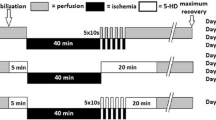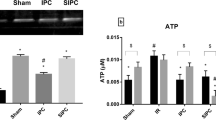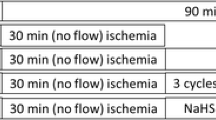Abstract
Background
This study investigated the cardioprotective effects of pharmacologic pretreatment with HOE642, a selective Na+/H+ exchanger (NHE) isoform-1 inhibitor, in immature rabbit hearts, as compared with ischemic preconditioning (IPC).
Methods
For this study, 36 isolated immature New Zealand white rabbit hearts were equilibrated on the Langendorff apparatus. They were randomly divided into three groups: control group, IPC group, and HOE642 group. The hearts in each group were subjected to 60 min of ischemia plus 60 min of reperfusion (I/R). In the IPC group, the hearts were preconditioned by 5 min of ischemia followed by 10 min of reperfusion before I/R. In the HOE642 group, the hearts were pretreated with HOE642 (5 μmol/l) for 15 min before I/R. Left ventricular performance (LVDP, +dp/dtmax, −dp/dtmax), coronory artery flow (CF), myocardial water content, adenosine triphosphate (ATP), cardiac-specific enzymes (creatine kinase [CK], CK fraction MB [CK-MB], and lacate dehydrogenase [LDH]), and intracellular calcium content were measured. Myocardial ultrastructure was observed under transmission electron microscopy.
Results
The recovery rates for left ventricular performance and CF in both the HOE642 and the IPC groups increased compared with those for the control subjects (p < 0.05). Moreover, the recovery rates for LVDP, +dp/dtmax, −dp/dtmax, and CF in the HOE642 group were markedly higher than in the IPC group at most time points of reperfusion (p < 0.05). Compared with the control group, CK, CK-MB, and LDH in the HOE642 group were decreased significantly (p < 0.05), whereas only LDH was reduced in the IPC group (p < 0.05). Water content was significantly reduced and ATP reserve was significantly increased in both the IPC and HOE642 groups (p < 0.05). However, compared with the IPC group, water content in the HOE642 group was significantly lower (81.26% ± 1.26% vs 83.58% ± 1.27%; p < 0.05) and ATP was significantly higher (21.46 ± 2.40 vs 17.66 ± 1.50 μg/g; p < 0.05). The HOE642 pretreatment exerted a better effect of reducing calcium overload than IPC (265.8 ± 41.1 vs 408.5 ± 56.8 mg/kg dry weight; p < 0.05). The blinded ultrastructural assessment under transmission electron microscopy showed that HOE642 brought about more myocyte salvage than IPC.
Conclusion
This study demonstrated that HOE642 pretreatment is superior to IPC against ischemia and reperfusion injury in isolated immature rabbit myocardium.


Similar content being viewed by others
References
Awad WI, Shattock MJ, Chambers DJ (1998) Ischemic preconditioning in immature myocardium. Circulation 98:206–213
Baetz D, Bernard M, Pinet C (2003) Different pathways for sodium entry in cardiac cells during ischemia and early reperfusion. Mol Cell Biochem 242:115–120
Baker JE, Holman P, Gross GJ (1999) Preconditioning in immature rabbit hearts: role of K+-ATP channels. Circulation 99:1249–1254
Baum VC, Victor C, Palmisano BW, Barbara W (1997) The immature heart and anesthesia. Anesthesiology 87:1529–1548
Behmanesh S, Kempski O (2000) Mechanisms of endothelial cell swelling from lactacidosis studies in vitro. Am J Physiol 279:H1512–1517
Bin Z, Tiehu Y, Su M, Cun L (2003) Absence of apparent cardioprotection following ischemic preconditioning in immature rabbit hearts. Heart Lung Circ 12:39–43
Camara AK, An J, Chen Q (2003) Na+/H+ exchange inhibition with cardioplegia reduces cytosolic (Ca2+) and myocardial damage after cold ischemia. J Cardiovasc Pharmacol 41:686–698
Castella M, Buckberg GD, Tan Z (2002) Myocyte and endothelial effects of preconditioning the jeopardized heart by inhibiting Na/H exchange. J Thorac Cardiovasc Surg 124:1113–1121
Castella M, Buckberg GD, Tan Z (2003) Blood cardioplegic protection in profoundly damaged hearts: role of Na+/H+ exchange inhibition during pretreatment or during controlled reperfusion supplementation. Ann Thorac Surg 75:1238–1245
Coles JG, Watanable T, Wilson GJ (1987) Age-related differences in the response to myocardium ischemic stress. J Thorac Cardiovasc Surg 94:526–534
Conway SJ, Koushik SV (2001) Cardial sodium–calcium exchanger: a double-edged sword. Cardiovas Res 51:194–197
Evrengul H, Seleci D, Tanrverdi H, Kaftan A (2006) The antiarrhythmic effect and clinical consequences of ischemic preconditioning. Coron Artery Dis 17:283–288
Gumina RJ, Beier N, Schelling P (2000) Inhibitors of ischemic preconditioning do not attenuate Na+/H+ exchange inhibitor–mediated cardioprotection. J Cardiovasc Pharmacol 35:949–953
Haist JV, Hirst CN, Karmazyn M (2003) Effective protection by NHE-1 inhibition in ischemic and reperfused heart under preconditioning blockade. Am J Physiol Heart Circ Physiol 284:H798–H803
Inserte J, Garcia-Dorado D, Hernando V, Barba I, Soler-Soler J (2006) Ischemic preconditioning prevents calpain-mediated impairment of Na+/K+-ATPase activity during early reperfusion. Cardiovasc Res 70:364–373
James G, Richard M (1998) Cardiac ischemia–reperfusion injury: preliminary study of the effect of sarcolemmal Na+/H+ exchange blockade in the isolated heart in two age groups of young rats. Pediatr Res 43:68
Karmazyn M, Sawyer M, Fliegel L (2005) The Na(+)/H(+) exchanger: a target for cardiac therapeutic intervention. Curr Drug Targets Cardiovasc Haematol Disord 5:323–335
Kevelaitis E, Qureshi AA, Mouas C, Marotte F, Kevelaitiene S, Avkiran M, Menasche P (2005) Na+/H+ exchange inhibition in hypertrophied myocardium subjected to cardioplegic arrest: an effective cardioprotective approach. Eur J Cardiothorac Surg 27:111–116
Kleyman TR, Cragoe EJ (1988) Amiloride and its analogs as tools in the study of ion transport. J Membr Biol 105:1–21
Letienne R, Bel L, Bessac AM, Denais D, Degryse AD, John GW, Le Grand B (2006) Cardioprotection of cariporide evaluated by plasma myoglobin and troponin I in myocardial infarction in pigs. Fundam Clin Pharmacol 20:105–113
Liu H, Cala PM, Anderson SE (1998) Ischemic preconditioning: effects on pH, Na+ and Ca2+ in newborn rabbit hearts during ischemia/reperfusion. J Mol Cell Cardiol 30:685–697
Masereel B, Pochet L, Laeckmann D (2003) An overview of inhibitors of Na+/H+ exchanger. Eur J Med Chem 38:547–554
Meno H, Jarmakani JM, Philipson KD (1989) Developmental changes of sarcolemmal Na+/H+ exchange. J Nol Cell Cardio 10:1017–1029
Murashita T, Yasuda K (2002) The role of Na+/H+ exchange in the efficacy of multidose hypothermic cardioplegia in immature rabbit hearts. Eur J Cardiothorac Surg 22:944–950
Rodriguez SA, Garcia DD, Padilla F, et al (2003) Pretreatment with the Na+/H+ exchange inhibitor cariporide delays cell-to-cell electrical uncoupling during myocardial ischemia. Cardiovasc Res 58:109–117
Ruiz-Meana M, Garcia-Dorado D, Pina P, Inserte J, Agullo L, Soler-Soler J (2003) Cariporide preserves mitochondrial proton gradient and delays ATP depletion in cardiomyocytes during ischemic conditions. Am J Physiol Heart Circ Physiol 285:H999–H1006
Stevens RM, Salik Jahania M, Mentzer RM Jr, Lasley RD (2004) Sodium–hydrogen exchange inhibition attenuates in vivo porcine myocardial stunning. Ann Thorac Surg 77:651–657
Turcato S, Turnbull L, Wang GY, Honbo N, Simpson PC, Karliner JS, Baker AJ (2006) Ischemic preconditioning depends on age and gender. Basic Res Cardiol 101:235–243
Acknowledgments
The HOE642 used in this study was a generous gift of Aventis Pharma Deutschland (Frankfurt am Main, Germany). The author thanks Bin Guan, Yan-wan Zhang, and Shi-yong Shi for their technical assistance, and professor Yun-Xia Zuo and Harold R. Howard for their revision of the English writing. This project was supported, in part, by grant no.30571785 from the National Natural Science Foundation of China, and grant no.2005CB522601 from the 973 Program.
Author information
Authors and Affiliations
Corresponding author
Rights and permissions
About this article
Cite this article
Zhou, RH., Long, C., Liu, J. et al. Inhibition of the Na+/H+ Exchanger Protects the Immature Rabbit Myocardium From Ischemia and Reperfusion Injury. Pediatr Cardiol 29, 113–120 (2008). https://doi.org/10.1007/s00246-007-9072-4
Received:
Revised:
Accepted:
Published:
Issue Date:
DOI: https://doi.org/10.1007/s00246-007-9072-4




